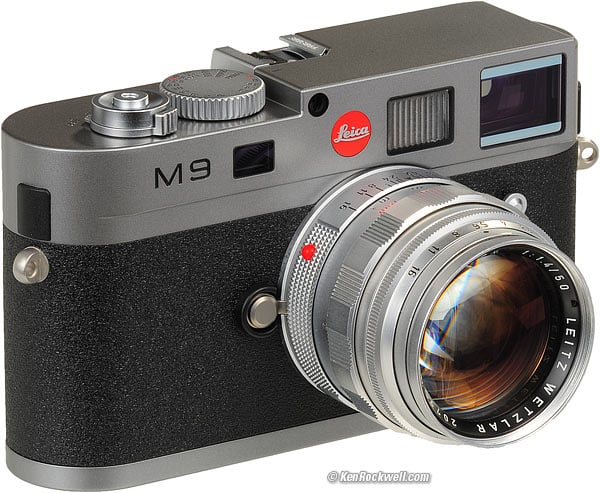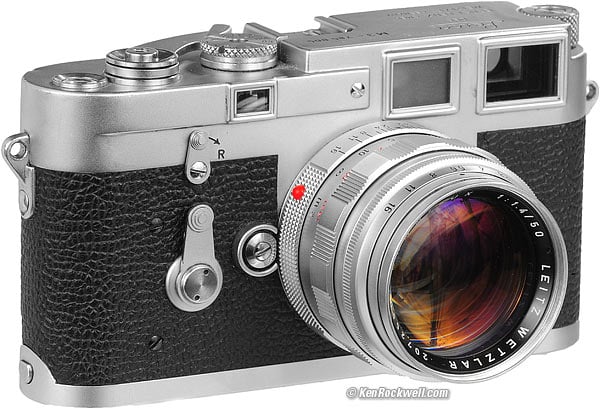Home Donate New Search Gallery How-To Books Links Workshops About Contact
Leica's Best Camera vs. Leica's Newest Camera
© 2010 KenRockwell.com. This page best with Corporate S regular and bold activated.
The LEICA M9, Leica's newest camera, and the world's best digital camera.
The LEICA M3 (1954-1967), Leica's best camera, period. bigger.
This all-content, junk-free website's biggest source of support is when you use those or any of these links to approved sources when you get anything, regardless of the country in which you live. Thanks for helping me help you! Ken.
October 2009 LEICA M9 Review More Leica Reviews
Introduction top
|
I personally buy from Adorama, Amazon, Ritz, B&H, Calumet and J&R. I can't vouch for ads below.
|
Everyone knows all about the LEICA M9, which was introduced in September 2009 and quickly heralded as the world's best digital camera.
In this case, the word "digital," as in "best digital camera," is a weasel word, used to exclude all other great cameras.
The LEICA M9 is the world's best digital camera, but when we open the field to include all cameras, the Mamiya 7 is the world's best camera, and the LEICA M3, made from 1954 through 1966, is Leica's best camera ever.
The M3 is unquestionably Leica's best camera. When introduced, it was by far the world's most technically advanced camera ever seen.
The LEICA M3 all at once updated Leica users to the bayonet lens mount, a flip-open film-loading door, a combined viewfinder and rangefinder system that let one see everything at the same time (called "Messsucher," from which the M system gets its "M"), a single shutter speed dial for all speeds, thumb-lever wind, an automatically-resetting film counter, automatic parallax correction, and a viewfinder which automatically switches itself to 35mm, 50mm, 90mm and 135mm lenses. (35mm lenses for the M3 use special auxiliary optics for the finder which reduce its magnification to let the 35mm field-of-view fill the big 50mm frame.)
Once Leica had created its masterpiece M3 of 1954, it's pretty much been downhill from there. Leica sold a quarter-million M3s, more than any of their cameras, ever.
The M3's automotive pairing is the Mercedes-Benz 300SL, introduced the same year.
The M2 of 1958-1967 was simply a poor man's Leica, with a cheaper, low-magnification viewfinder-rangefinder and no automatic film counter. The M1 didn't even have a rangefinder. The M4 (1967-1975) is the M2 with a canted rewind knob.
The M5 (1971-1975) was a big, heavy, ugly beast.
The M4-2 (1978-1980) and M4-P (1981-1987) were even cheaper, simpler cameras. They were made in Canada to save even more money.
One of the best LEICAs is the Minolta CLE (1980-1985), but whoops, that is a plasticy Minolta camera, made after Leica dumped the made-in-Japan-by-Minolta CL (1973-1976).
The LEICA M6 (1984-2002), M7 (2002-today) and MP (2003-today) are great cameras, but still not as good as the M3. Their finders are inferior to the M3, with low magnifications, too many junk frames obscuring the view, and some versions won't work with some lenses, like the extraordinary LEICA SUMMICRON 50mm f/2 mit near-focusing range (1956-1968).
Anyway, we could go on forever about which is really Leica's best, but what I really want to do is compare the M9 with the M3, since after shooting both next to each other for a week in Yosemite and the Eastern Sierra, the differences became apparent.
All LEICAs today share the innovations first introduced in 1955. The only things newer cameras offer are TTL metering, automatic shutter-speed control or digital capture, but that's it! Otherwise, the M9 is the same as the M3 with a crummy finder.
Or is it? Let's see.
The most obvious difference is that the the M9 is a clunky motorized beast compared to the silky M3. The M9 is not the smooth, collected, quiet camera that is the M3.
Shooting the M3, all you see is your big, bright, uncluttered image in the finder, all you feel is your finger smoothly sliding into the camera, and all you hear is a silent clunk as the shutter operates.
By comparison, the M9's smaller, cluttered finder seems like it's broken by comparison, its shutter button feels like something is inside trying to fight you, and it sounds and feels like a Polaroid SX-70 gone berserk, with its noisy motor running after each shot to cock the shutter. (The M9 is much quieter than an SLR; it is noisy only to the discerning ear of the LEICAMAN.)
With the M3, no motor is needed; just use your thumb. The M9 would be much nicer with a cloth shutter and thumb lever to cock the shutter. The M9 feels more like an industrial product, not a smooth classic.
The M3's shutter goes off with one smooth press. The M9's shutter release is loaded with all sorts of kinks as you press it. The M9 has about three different levels of detent as you try to release the shutter.
The M3's viewfinder and rangefinder is the best ever made by Leica. It works great for every lens up to 135mm, with the largest magnification of any Leica ever made. The M3's frame lines are complete rectangles, never with any other finder lines inside the frame you're actually using.
The M9's finder is the same dinky thing as every other Leica since 1980: low magnification to cover 28mm lenses (which you can't see anyway since the eyepiece is too small), and in its attempt to cover more lenses, the newer cameras, including the M9, show frame lines inside the frame line you're trying to use, and worse, the newer cameras rarely have compete frames and instead often just offer incomplete line segments, or just four corners.
All Leica M cameras are limited by the M3's original set of three automatically-selected frame lines. In the M3, it couples to uniquely to 50mm, 90mm and 135mm frame lines, and 35mm lenses reduce the finder magnification with external optics to use the big, clean 50mm frame.
Since there are only three selections automatically keyed by the lenses, newer cameras have to double-up frame lines and throw-up two different frame lines for each lens.
To cover 28mm lenses, newer cameras call up the same key as 90mm lenses, 35mm lenses piggyback on the 135mm key in newer cameras, and 75mm lenses come up at the same place as 50mm lenses. With newer cameras, your viewfinder is always messy, not a quiet place for compositional reflection.
The rangefinder? The spot on the M3 is big and sharp. It's easy to get perfect focus with 135mm lenses.
With newer cameras, the RF spot is smaller and less magnified. Good luck seeing it well enough for use with longer lenses, unless maybe you want to screw with external magnifiers.
Let's face it: the M3 just feels better to shoot. The M3, like the Nikon F6, is smooth, quiet and has a huge, clear, uncluttered viewfinder. The M3 is so pleasant to shoot that you just want to pick it up and shoot it, even if there's nothing worth shooting.
The M9 by comparison is a clunky beast, with its notchy shutter release, noisy motorized advance, and a finder that seems like it's broken compared to the M3's Meisterstück (masterpiece) of a rangefinding viewfinder system. You shoot the M9 because you want the images it can produce, not because it feels so good doing it. You can set the M9's shutter release to forgo the AE Lock, and remove one notch from the process, but not them all.
Finder
After using the M3, looking through the finder of any other Leica looks like something's wrong with it.
The M3 has a big, uncluttered finder, while newer cameras have smaller finders loaded with junk to cover more lenses you don't need.
Let's be honest: a camera's finder is at least half the experience of shooting with it, and the M3 has the best finder ever found in a Leica.
| Magnification | 0.92x |
0.68x |
| Framing accuracy | Pretty accurate. |
Finder covers much less than actual image area, leading to loose, weak compositions. |
| Lenses covered | 35,* 50, 90, 135mm |
28, 35, 50, 75, 90, 135mm |
| Are there any other lines inside the frame of the lens you're using? | Never. |
Usually: 75mm frame is inside the 50mm frame, 90mm frame is inside the 28mm frame, and the 135mm frame is inside the 35mm frame. |
| Does the finder show a complete rectangular frame, or just pieces? | Full rectangles, always, for all four lenses. |
Only fractional frames (50mm), sometimes just line segments (28, 35 and 90mm), other times, just corners (75, 135mm). |
| Rangefinder spot size | Big. |
Medium. |
| RF effective base length | 63.71mm |
47.1mm |
| Focus accuracy rated OK for lenses | 16 - 135mm |
16 - 90mm |
* Use 35mm lenses designed for the M3, which have auxiliary optics to change the finder magnification.
So much for tables; here are two otherwise identical snaps of the LEICA M3's finder and the LEICA M9's finder, each looking at the sky with the same 50mm lens:
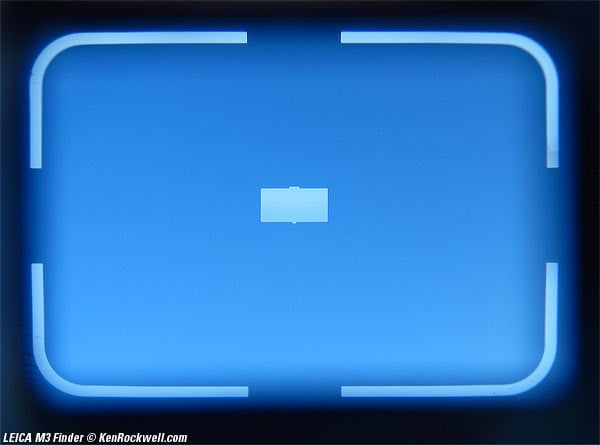
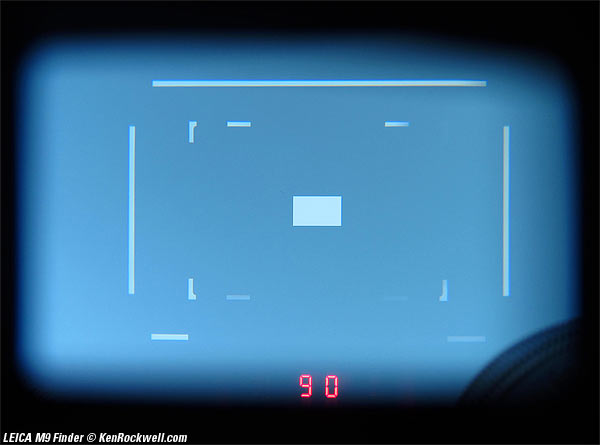
The M9's finder frames are thinner, weaker and less distinct. Worse, there is a 75mm frame inside the 50mm frame we want! There really isn't any bottom to the M9's 50mm frame, and it doesn't look any better during actual use.
With a blank sky, the M9's frame lines are visible. They are more difficult to see with actual subjects. Here's two more snaps, this time looking at my computer monitor with the same 50mm lens:

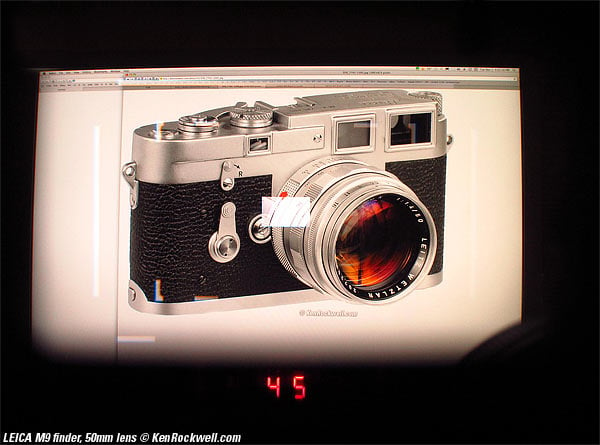
The M3's finder is to-the-point, while it's difficult to see the M9's frame lines lost inside a jumble of mush. With an actual subject, it's also obvious how much smaller is the M9's puny low-magnification finder.
Looking through the M3's finder is like sitting down in a real sports car or spacecraft: direct and to the point: you're in control and you're going to go!, while the M9's finder is more like sitting on a bus: you're input isn't particularly relevant to whatever's going to happen. The M3's finder is all about control and your subject, not confusion.
Feel
The M3 is a smooth, silent classic, while the M9 bucks like a bronco after you press its clunky, several-click-deep shutter release.
| Shutter button | One silky-smooth push-in. |
A ratchety affair with at least three different clicks as you try to force it in. |
| Shutter noise | One soft clunk. |
One harder click. |
| Advance noise | None, just a thumb lever. |
A nasty, noisy internal motor.* |
| Shutter dial | Tiny; hard to move by itself, but easy to move when used with any Works with any of the coupled LEICAMETERs for foolproof semiautomatic exposure setting.. |
Easy to flick with a fingertip. |
| Fake-leather grippiness | Grippy. |
More slippery (silver-gray version). |
* Nasty compared to a regular Leica; still almost silent compared to a DSLR.
Specifications
| Shutter | B, 1- 1,000 |
T, B, 8 - 1/4,000 |
| Material | Cloth. |
Metal. |
| Longest exposure time | Unlimited. |
4 minutes. |
| Battery | none. |
dedicated rechargeable. |
| Shots per charge | unlimited. |
about 400. |
| Weight, actual, as deployed | 20.8oz/590g |
20.9oz/593g |
| Compatible with | All Leica lenses. |
|
| Tripod thread | 3/8;" use an adapter for 1/4." |
standard 1/4." |
| Tripod socket location | Right side. |
Random spot on bottom. |
| Tripod socket easy to find at night? | Yes. |
no. |
Shooting
| Easy to shoot with lens cap on? | Yes. |
Not if in AUTO or using TTL meter. |
| Metering | Coupled LEICAMETER, several models. |
Internal TTL. |
| Meter with 21mm finder attached? | No, need the shoe for either the 21mm finder or for the meter.* |
Yes. |
| Automatic exposure? | no. |
Yes. |
| Infinitely variable manual shutter speeds? | Yes. |
no. |
| Need to play with menus when changing lenses? | Never. |
Yes, with non-6-bit lenses. |
| Need to be careful not to let the Sun burn a hole in the shutter? | Yes. |
Not really. |
| Good idea to keep the cap on when not shooting? | Yes, helps prevent light leakage around the shutter curtains. |
No need, only captures images as shot. |
| Works at -5ºC (23ºF)? | Perfectly. |
Perfectly. |
| Works with 50mm SUMMICRON with close-focusing range? | Perfectly. |
no, can't focus closer than 1 meter or beyond 4 meters. |
* Since I shoot with 21mm lenses, I can't leave my M3's LEICAMETER attached, so I have to use an external, uncoupled meter.
Style
| Colors | Chrome (black very rare). |
Black or Titanium. |
| Ornate top-cover openings? | Yes, trim around every hole. |
No, just a flat front. |
Image Quality
I prefer film and therefore the M3. I prefer the look of of Fuji Velvia 50 to digital capture.
For use in low-light, the M9 is much more sensitive with much less noise or grain than film.
Recommendations top
Even though the M3 feels better, the M9 shoots much faster due to automatic exposure, TTL metering that automatically compensates for filters, and automatic shutter cocking for the next shot.
The M3 is great for when you have a few seconds to meter and set exposures manually, while the M9 just shoots and answers your questions later.
The M9 makes a great light meter and exposure preview system for the M3, which of course takes longer than just taking the picture with the M9.
Set to ISO 160, simply add two stops to the M9's exposure to get the exposure for Velvia 50 and an 81A filter.
This is all academic. Most people want digital cameras, and the LEICA M9 is the world's best digital camera, so this discussion is a moot issue.
Help me help you top
I support my growing family through this website, as crazy as it might seem.
If you find this as helpful as a book you might have had to buy or a workshop you may have had to take, feel free to help me continue helping everyone.
If you've gotten your gear through one of my links or helped otherwise, you're family. It's great people like you who allow me to keep adding to this site full-time. Thanks!
If you haven't helped yet, please do, and consider helping me with a gift of $5.00.
The biggest help is when you use any of these links when you get anything. It costs you nothing, and is this site's, and thus my family's, biggest source of support. These places always have the best prices and service, which is why I've used them since before this website existed. I recommend them all personally.
Thanks for reading!
Ken
Home Donate New Search Gallery How-To Books Links Workshops About Contact

